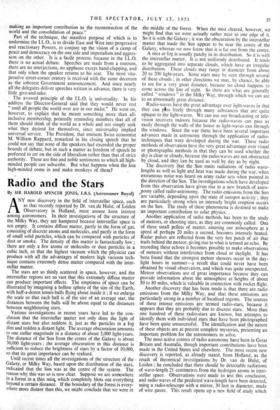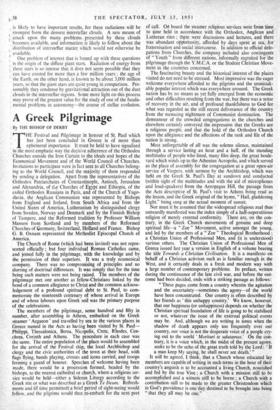Radio and the Stars
By SIR HAROLD SPENCER JONES, F.R.S. (Astronomer Royal)
NY NY new discovery in the field of interstellar space, such as that recently reported by Dr. vane Hulst, of Leiden Observatory in Holland, must arouse keen interest among astronomers. In their investigations of the structure of the Milky Way, they are hampered because interstellar space is not empty. It contains diffuse matter, partly in the form of gas, consisting of discrete atoms and molecules, and partly in the form of small solid particles, which can be compared with particles of dust or smoke. The density of this matter is fantastically low ; there are only a few atoms or molecules or dust particles in a cubic inch, so that the highest vacuum which the physicist can produce with all the advantages of modern high vacuum tech- nique contains extremely dense matter compared with the inter- stellar matter.
The stars are so thinly scattered in space, however, and the interstellar regions are so vast that this extremely diffuse matter can produce important effects. The emptiness of space can be illustrated by imagining a hollow sphere of the size of the Earth. with half-a-dozen tennis-balls flying about inside it ; if we enlarge the scale so that each ball is of the size of an average star, the distances between the balls will be about equal to the distances between neighbouring stars.
Various investigations in recent years have led to the con- clusion that the interstellar matter not only dims the light of distant stars but also reddens it, just as the particles in a fog dim and redden a distant light. The average obscuration amounts to one stellar magnitude in a distance of about 3,000 light-years. The distance of the Sun from the centre of the Galaxy is about 30,000 light-years ; the average obscuration in this distance is sufficient to reduce the brightness of stars by a factor of 10,000, so that its great importance can be realised. Until recent times all the investigations of the structure of the Galaxy, or Milky Way, based upon the distribution of the stars, indicated that the Sun was at the centre of the syStem. The reason why this was so is now clear. Suppose we are somewhere in a forest in a thin mist, which completely blots out everything beyond a certain distance. If the boundary of the forest is every- where more distant than this,.we might conclude that we were in the middle of the forest. When the mist cleared, however, we might find that we were actually rather near to one edge of it. So it is with the Galaxy ; it was the obscuration by the interstellar matter that made the Sun appear to be near the centre of the Galaxy, whereas we now know that it is far.out from the centre.
A mist or fog is usually patchy in its distribution. So it is with the interstellar matter. It is not uniformly distributed. It tends to be aggregated into separate clouds, which have an irregular distribution. These clouds may range in diameter from about 20 to 200 light-years. Some stars may be seen through several of these clouds ; in other directions we may, by chance, be able to see for a very great distance, because no cloud happens to come across the line of sight. So there are what are generally called " windows " in the Milky Way, through which we can see to an abnormally great distance.
Radio-waves have the great advantage over light-waves in that they can piss freely through many substances that are quite opaque to the light-waves. We can use our broadcasting or tele- vision receivers indoors because the radio-waves can pass as easily through the walls of the house as light-waves can through the windows. Since the war there have been several important advances made in astronomy through the application of radio- techniques that were developed during the war. These radio methods of observation have the very great advantage over visual or photographic methods in that they can be used whether the sky is clear or cloudy, because the radio-waves are not obstructed by cloud, and they can be used as well by day as by night.
The discovery that the Sun emits radiations of radio wave- lengths as well as light and heat was made during the war, when extraneous noise was heard on army radar sets when pointed in the direction of the Sun. The investigations which have developed from this observation have given rise to a new branch of astro- .pomy called radio-astronomy. The radio emissions from the Sun are variable, depending upon the state of sunspot activity ; they are particularly strong when an intensely bright eruption occurs on the Sun. The study of these phenomena is destined to make an important contribution to solar physics.
Another application of radio methods has been to the study of meteors, or shooting stars, as they are commonly called. One of these small pellets of matter, entering our atmosphere at a speed of perhaps 20 miles a second, becomes intensely heated. Radar pulses are reflected from the very hot patch of air that trails behind the meteor, giving rise to what is termed an echo. By recording these echoes it becomes possible to make observations . of meteors without interference from cloud or daylight. It has been found that the strongest meteor showers occur in the day- light hours in summer—a result that could never have been obtained by visual observation, and which was quite unexpected. Meteor observations are of great importance because they can provide information about the atmosphere at heights of about 50 to 80 miles, which is valuable in connection with rocket flight.
Another discovery that has been made is that there are radio emissions from the Milky Way, and that these emissions are particularly strong in a number of localised regions. The sources of these intense emissions are termed radio-stars, because it appears that they are probably due to discrete stars. More than one hundred of these radio-stars are known, but attempts, to identify them with individual stars that have been photographed have been quite unsuccessful. The identification and the nature of these objects are at present complete mysteries, prisenting an important problem for the astronomers to solve. The most active centres of radio astronomy have been in Great Britain and Australia, though important contributions have been made in the United States and elsewhere. The most recent new discovery is reported, as already stated, from Holland, as the result of theoretical investigations by Dr. van de Hulst, of Leiden ; he concluded that there should be detectable radiations of wave-length. 21 centimetres from the hydrogen atoms in inter- stellar space. Observations were made to test this conclusion, and radio waves of the predicted wave-length have been detected, using a radio-telescope with a mirror, 30 feet in diameter, made of wire gauze. This result opens up a new field of study which is likely to have important results, for these radiations • will be strongest from the densest interstellar clouds. A new means of attack upon the many. problems presented by these clouds becomes available, and information is likely to follovi about the t distribution of interstellar matter which would not otherwise be available.
One problem of interest that is bound up with these questions is the origin of the diffuse giant stars. Radiation of energy from these stars is so intense that it does not seem possible-that they can have existed for more than a few million years ; the age of the Earth, on the other hand, is known to be about 3,000 million years, so that the giant stars are quite young in comparison. Pre- . sumably they condense by gravitational attraction out of the dust clouds in the interstellar regions. Some more light on this process may prove of the greatest value for the study of one of the funda- ,, mental problems in astronomy—the course of stellar evolution.







































 Previous page
Previous page